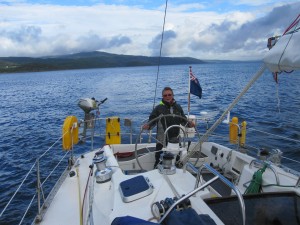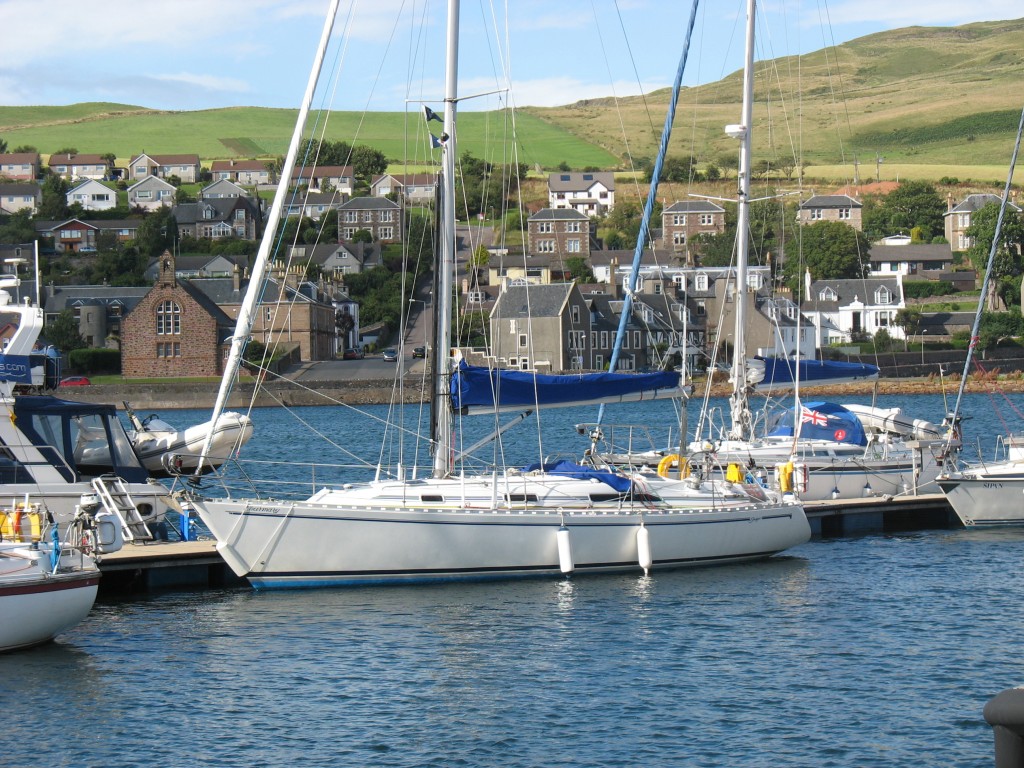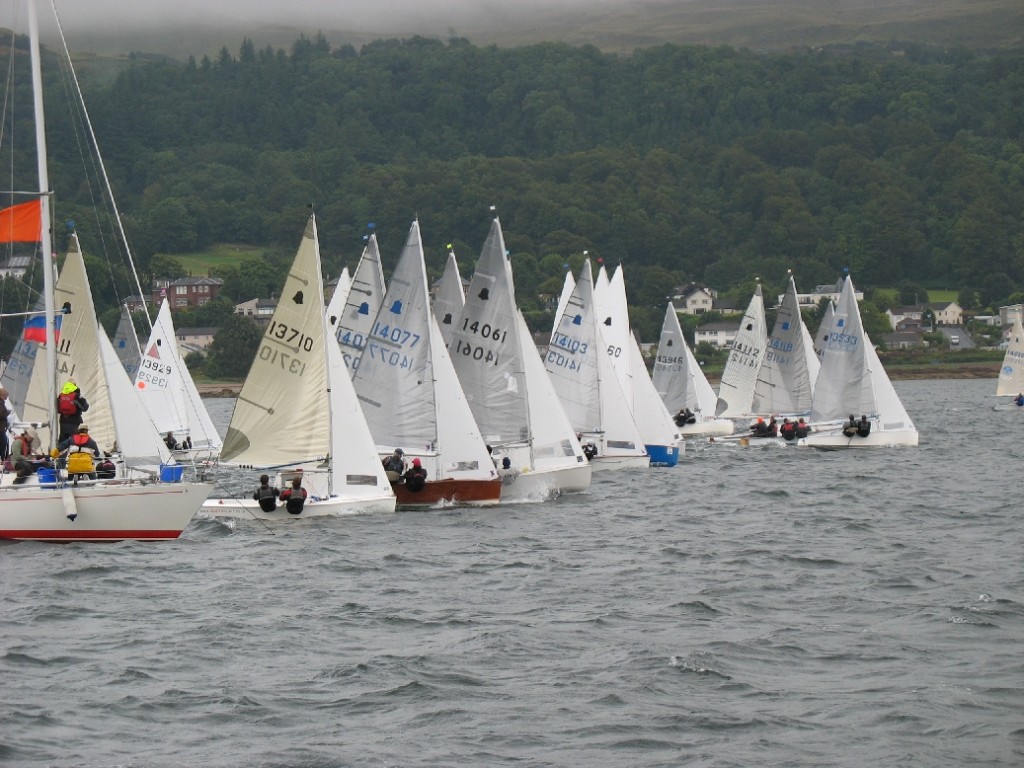
In August we had signed up for the RYA Scotland Malin Waters Cruise. I headed up to the boat with Derek and Adie as crew on Thursday August 8th. We arrived at Rhu mid-afternoon, filled up with fuel and stocked the boat up. On Friday, we headed off mid-morning (after a stop in the Helensburgh wool shop) and sailed down to Largs.
August 9th – Rhu to Largs – 20.5 miles in 3 hours and 45 minutes
A bizarre trip. We hoisted sail (one reef – full jib) straight out of the marina and tacked down towards Cloch Point. The wind was very variable but around N/NW 3-5. On rounding Cloch Point, the wind dropped to almost nothing, making our reef slightly unnecessary! In the meantime on the Dunoon shore we watched boats with reefs in broaching in water covered with white caps, while we struggled to even gain steerage way on the Inverkip shore. Eventually, the breeze filled in a little and finally as we approached Largs, it built to a healthy 5 gusting 6.
Sailing past Kip, I could have sworn something looked different. Eventually I realised that there was a vast chimney missing! In the few weeks since we had last sailed past, the Inverkip power station chimney had been demolished. Inverkip power station was an oil-fired power station, but the most outstanding feature of it was the 237 metre chimney – the tallest free-standing structure in Scotland and the same height as Canary Wharf in the docklands. As you can see from the video below, it took a lot less time to come down than to go up.
That evening we had a briefing about the cruise. However, with an ‘interesting’ and very variable forecast, we eventually decided to pull out of the cruise. The main reason for this decision (aside from dodgy weather at the end of the week) was that they decided to head straight for Rathlin the first day – a decision that would have meant a 70 mile passage, near enough all under power. So, we decided to head off elsewhere and make sure we could sail.
August 10th – Largs to East Loch Tarbert – 27.6 miles in 5 hours and 35 minutes
A lovely passage. A little quiet to start off with as we headed through Cumbrae Passage, but the breeze filled in a little and gradually rose giving us a lovely sail round Bute to East Loch Tarbert.
August 11th – East Loch Tarbert to Campbeltown – 35.7 miles in 6 hours
The forecast was not a classic one, but with a westerly expected we decided to head straight down Kilbrannan Sound to Campbeltown. In fact, the first hour down to Skipness Point was very quiet and right on cue the wind headed us meaning we could only make Loch Ranza on starboard. We did a tack across towards the Mull and after half an hour or so, the wind headed us a little allowing us to tack and make it down Kilbrannan Sound on one tack. As we passed Carradale the wind rose and on the last leg into Campbeltown was blowing a healthy F5 gusting 6 into Campbeltown Loch. However, this gave us a lovely run down the sound topping 8 knots for the final stages. 8.4 knots was the top speed!
At Campbeltown we moored on the pontoon close by the commercial harbour. Campbeltown apparently had at one point 34 distilleries meaning that it was known as the “whisky capital of the world“. A focus on quantity rather than quality and the unfortunate combination of the Great Depression and prohibition took their toll though and there are now just three distilleries left.

August 12th – Campbeltown to Lamlash via Ailsa Craig – 43.4 miles in 6 hours and 30 minutes
A cracking sail from Campbeltown. With a moderate F4-6 from the north west forecast, we decided to run down to Ailsa Craig, round the rock and then head up to Lamlash Bay on Arran. If that was a little tight or the wind shifted then we would head for Troon instead. We headed across to Ailsa Craig on a broad reach and gybed across after a few hours to round the rock. I had passed it already earlier in the season and realised the scale of the rock, but I hadn’t realised the scale of the bird population on the rock. What looked like rock from a distance was in fact a mass of gannets and other birds nesting on the rock. The closer we came to the rock, the more gannets and shearwaters we saw – a fantastic sight.
Rounding the rock, we headed up on a close reach and with the wind gusting a F6 at times, had a great sail across to Lamlash. the record speed for the day was 8.9 knots. Though it was a bit grey and murky when we entered the bay, it cleared later in the evening, giving us a lovely view of Holy Isle and Lamlash. The only slight downside was that we had to move to another buoy at about 9pm when we almost swung into the boat next door. Clearly long keel and wing keel boats on next door moorings don’t mix when the vagaries of light winds and light tides are combined.
August 13th – Lamlash to Portavadie – 28 miles in 5 hours and 55 minutes
A complete contrast today as we headed north round Arran to Portavadie on Loch Fyne. We managed to sail off the mooring in Lamlash, but the wind stayed very light, shifted right round into the north (where we wanted to go!) and then died completely. After an hour or so of motoring, a light breeze filled in, but there was another hour or so of motoring again later as it died again. Still – we managed to sail the majority of the trip, though the best breeze came just as we headed into Portavadie marina.
August 14th – Portavadie to Port Bannatyne – 22 miles in 4 hours and 40 minutes
A lovely sail – quite light to start off with as we beat down towards Ardlamont Point, but once we bore away round the point the wind filled in from behind and we had a lovely spinnaker run down the West Kyle. We did have to drop the spinnaker at Rubha Dubh and then a white sail reach across to the Burnt Islands (though we did also stick our nose into Caladh harbour). We then motorsailed down the East Kyle with the wind right on the nose and gusting a little, eventually bearing away into Kames Bay – Port Bannatyne.
August 15th – Port Bannatyne to Rhu via Little Cumbrae Island – 42 miles in 7 hours and 50 minutes
With slightly murky (for which read wet!) forecast, we decided to head out from Port Bannatyne and head south round Little Cumbrae Island before heading home for Rhu. We nearly bottled out and went through Cumbrae Passage when the rain came in, but the weather cleared a little and so we carried on round the southern tip of Cumbrae Island and then bore away down the Hunterston Channel and had a lovely run back to Largs. Once there we wound the jib in and the shadowed the GP14 nationals fleet watching the last few legs of their first race. we then stayed and watched the start of the second race – great fun.
From there we headed back to Rhu with a very variable wind – anywhere between 10 and 24 knots and shifts of around 50 degrees. However, we had a nice run until around Gourock when the wind essentially died and we motored the last few miles. A lovely end to a really nice tour around the Clyde.

